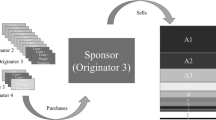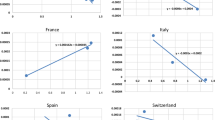Abstract
The credit sensitivity of LIBOR helped lenders during the financial crisis. SOFR is not credit-sensitive and would not have provided that support. The cumulative additional interest from LIBOR during the crisis is estimated to be between 1 to 2% of the notional amount of outstanding loans, depending on the tenor and type of SOFR rate used. The amount of LIBOR business loans owned by banks could have been as high as about 2trn, and the overall additional interest income banks received thanks to LIBOR could have been as high as 30bn dollars. The analysis also shows that a compounded SOFR reduces insurance relative to a term SOFR.



Similar content being viewed by others
Notes
In particular, the compounded rate is.
$${O}_{t}=\left(\frac{365}{N}\right)\times \left({\prod }_{j=t}^{t+N-1}\left(1+\frac{{O}_{j}^{d}}{360}\right)-1\right),$$where N equals either 30 or 91, and \(O_j^d\) is the overnight rate at date j.
References
Aramonte S, Lee SJ, Stebunovs V (2019) Risk taking and low longer-term interest rates: Evidence from the U.S. syndicated term loan market. J Bank Finance 138:105511
Bailey A (2017) The future of LIBOR. 27/07/2017 speech by Andrew Bailey, Chief Executive of the FCA. https://www.fca.org.uk/news/speeches/the-future-of-libor
Berndt A, Duffie JD, Zhu Y (2020) Across-the-curve credit spread indices. Stanford University Graduate School of Business, July 23 2020, Working Paper No. 3884
Berrospide JM, Meisenzahl RR (2015) The Real Effects of Credit Line Drawdowns. Finance and Economic Discussion Series 2015–007. Board of Governors of the Federal Reserve System (U.S.). https://doi.org/10.17016/FEDS.2015.007
Bord VM, Santos JAC (2012) The rise of the originate-to-distribute model and the role of banks in financial intermediation. Federal Reserve Bank of New York, Economic Policy Rev 18(2)
Cooperman HR, Duffie D, Luck S, Wang ZZ, Yang Y (2023) Bank Funding Risk, Reference Rates, and Credit Supply. National Bureau of Economic Research, Working Paper 30907
Duffie D, Stein JC (2015) Reforming LIBOR and other financial market benchmarks. J Econ Perspect 29(2):191–212
Financial Stability Board (2014) Market participants group on reforming interest rate benchmarks. Final Report, pp 311–316
Irani RM, Iyer R, Meisenzahl RR, Peydro JL (2021) The rise of shadow banking: evidence from capital regulation. Rev Financ Stud 34(5):2181–2235
Ivashina V, Scharfstein DS (2010) Bank lending during the financial crisis of 2008. J Financ Econ 97(3):319–338
Jermann U (2019b) Is SOFR better than LIBOR? Wharton School University of Pennsylvania, unpublished manuscript. https://ssrn.com/abstract=3361942
Klingler S, Syrstad O (2021) Life after LIBOR. J Financ Econ 141(2):783–801
Kuo D, Skeie D, Vickery J (2018) A comparison of libor to other measures of bank borrowing costs. unpublished manuscript. https://ssrn.com/abstract=3272370
Liu E, Schmidt-Eisenlohr T (2019) Who owns U.S. CLO Securities? FEDS Notes, Washington: Board of Governors of the Federal Reserve System. https://doi.org/10.17016/2380-7172.2423
Shared National Credit Program (2020) 1st and 3rd quarter 2019 reviews. Board of Governors of the Federal Reserve System, Federal Deposit Insurance Corporation, Office of the Comptroller of the Currency Washington, D.C.
Acknowledgements
I am grateful for comments from Darrell Duffie, Andrei Magasiner, Michael Roberts and Michael Schwert.
Author information
Authors and Affiliations
Corresponding author
Ethics declarations
Competing interests
The author has no relevant financial or non-financial interests to disclose.
Additional information
Publisher's Note
Springer Nature remains neutral with regard to jurisdictional claims in published maps and institutional affiliations.
Appendix
Rights and permissions
Springer Nature or its licensor (e.g. a society or other partner) holds exclusive rights to this article under a publishing agreement with the author(s) or other rightsholder(s); author self-archiving of the accepted manuscript version of this article is solely governed by the terms of such publishing agreement and applicable law.
About this article
Cite this article
Jermann, U. Interest Received by Banks during the Financial Crisis: LIBOR vs Hypothetical SOFR Loans. J Financ Serv Res (2023). https://doi.org/10.1007/s10693-023-00415-5
Received:
Revised:
Accepted:
Published:
DOI: https://doi.org/10.1007/s10693-023-00415-5




